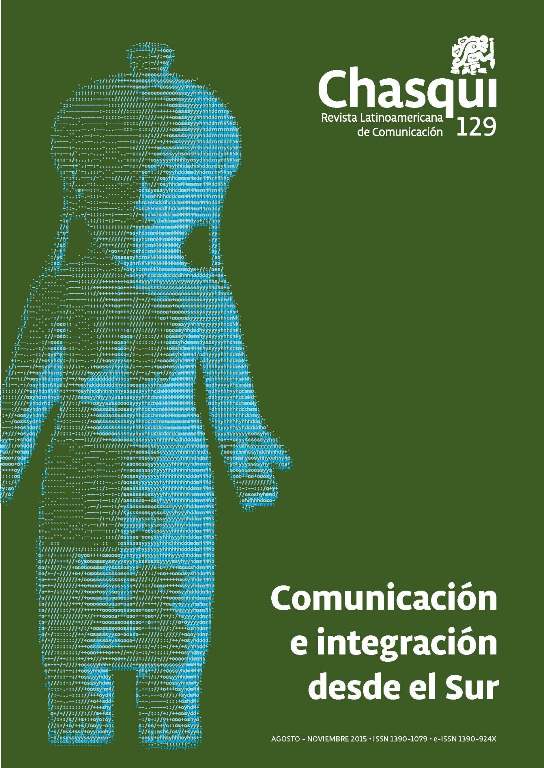Rethinking internet regulations. Analysis of political tensions between non-regulate and re-regulate the network-of-networks
DOI:
https://doi.org/10.16921/chasqui.v0i129.2470Keywords:
regulations, digital technologies, internet, neutrality, isonomiaAbstract
This article analyzes some of the political tensions that cross internet regulations: specifically, the positions facing the non-regulation of the internet (and its neutralities) with trends toward possible re-regulation of the network-of-networks. The work is part of a larger research that seeks to analyze and rethink the architectural principles (technological and legal-political) of internet. Its purpose is to strengthen discussions on the field of internet regulations at regional level and contribute to the development of digital technologies oriented to social inclusion and fair distribution of the wealth of humanity.References
Assange, J. (2013). Criptopunks: La libertad y el futuro de internet. Buenos Aires: Marea / Trilce.
Assange, J. (2014). Wikileaks: When Google Met Wikileaks. Nueva York: OR Books.
Baran, P. (1964). On Distributed Communications: I. Introduction to Distributed Communications Networks. Recuperado de http://www.rand.org/pubs/research_memoranda/2006/RM3420.pdf.
Benkler, Y. (2006). The wealth of the networks: How Social Production Transforms Markets and Freedom. Estados Unidos de Norteamérica: Yale University Press.
Berners Lee, T. (2000). Tejiendo la red: el inventor del World Wide Web nos descubre su origen. Madrid: Siglo XXI.
Bijker, W. (1995). Of Bicycles, Bakelites, and Bulbs: Toward a Theory of Sociotechnical Change. Cambridge, MA: MIT Press.
Blum, A. (2012). Tubos: En busca de la geografía física de internet. México DF: Océano.
Boyle, J. (1997). “Foucault in Cyberspace: Surveillance, Sovereignty, and Hard-Wired Censors”. En Law Review N° 66, pp. 177-205, University of Cincinnati. Recuperado de http://scholarship.law.duke.edu/faculty_scholarship/619/.
Boyle, J. (2008). The Public Domain: Enclosing the Commons of the Mind. Estados Unidos de Norteamérica: Caraban Books.
Castells, M. (2001). La Galaxia internet. Madrid: Areté.
Castells, M. & Himanen, P. (2014). Reconceptualizing Development in the Global Information Age. Oxford: Oxford Univesity Press.
Declaración Universal de Derechos humanos. (1948). “Naciones Unidas”. Recuperado de http://www.un.org/es/documents/udhr/.
Dixon, P. & Gellman, R. (2014). The scoring of America: How Secret Consumer Scores Threaten Your Privacy and Your Future. World Privacy Forum. Recuperado de http://www.worldprivacyforum.org/ wp-content/uploads/2014/04/WPF_Scoring_of_America_April2014_fs.pdf.
Felber, C. (2014). La economía del bien común: un modelo económico que supera la dicotomía entre capitalismo y comunismo para maximizar el bienestar de nuestra sociedad. Ciudad Autónoma de Buenos Aires: Paidós.
Fitzpatrick, P. (1998). La mitología del derecho moderno. México DF: Siglo XXI.
Foucault, M. (1991). Vigilar y Castigar: nacimiento de la prisión. Buenos Aires: Siglo XXI.
Greenwald, G. (2014). No place to hide: Edward Snowden, the NSA and the Surveillance State. New York: Metropolitan.
Hayek, F. (2007). Camino de servidumbre. Madrid: Alianza Editorial.
Himanen, P. (2001). La ética del hacker y el espíritu de la era de la información. Buenos Aires: Destino.
Internet World Stats. (2015). “Internet Users in the World”. Última visita el 18 / 03/ 15. Recuperado de http://internetworldstats.com/stats.htm
ITU (2014). “Measuring the Information Society Report 2014. International Telecommunication Union, United Nation”. Recuperado de http://www.itu.int/en/ITU-D/Statistics/Documents/publications/mis 2014/MIS2014_without_Annex_4.pdf.
Jeanneney, J. N. (2007). Google and the myth of universal knowledge: a view from Europe. Londres: University of Chicago Press.
Lessig, L. (1999). Code and other laws of cyberspace. New York: Basic Books Lessig, L. (2001). The future of the ideas: the fate of the commons in a connected world. Nueva York: Random House.
Lessig, L. (2004). Free Culture: How Big Media Uses Technology and the Law to Lock Down Culture and Control Creativity. Nueva York: Penguin Press.
Lessig, L. (2006). Code: Version 2.0. Nueva York: Basic Books.
Lewis, B. (dir.). (2013). Google and the World Brain. USA: Polar Star Films & BLTV. Recuperado de http://www.worldbrainthefilm.com/.
Ley N° 12965 de la República Federativa del Brasil. 23 de abril de 2014. Congresso Nacional. Recuperado de http://www.planalto.gov.br/ccivil_03/_ato2011-2014/2014/lei/l12965.htm.
Morozov, E. (2011). The Net Delusion: The Dark Side of internet Freedom. PublicAffairs. EE.UU.
Network Working Group [NWG]. (1996, junio). Architectural Principles of the internet. Request for Comments (RFC) 1958. Recuperado de http://www.ietf.org/rfc/rfc1958.txt.
Oudshoorn, N. & Pinch, T. (2005). How Users Matters: the co-construction of users and technology. Cambridge, MA: MIT
Downloads
Published
Issue
Section
License
- Authors retain copyright and grant the journal right of first publication with the work simultaneously licensed under a Creative Commons Attribution-NoDerivs License (CC BY-ND) that allows others to share the work with an acknowledgement of the work's authorship and initial publication in this journal.
- Authors are able to enter into separate, additional contractual arrangements for the non-exclusive distribution of the journal's published version of the work (e.g., post it to an institutional repository or publish it in a book), with an acknowledgement of its initial publication in this journal.
- Authors are permitted and encouraged to post their work online.

